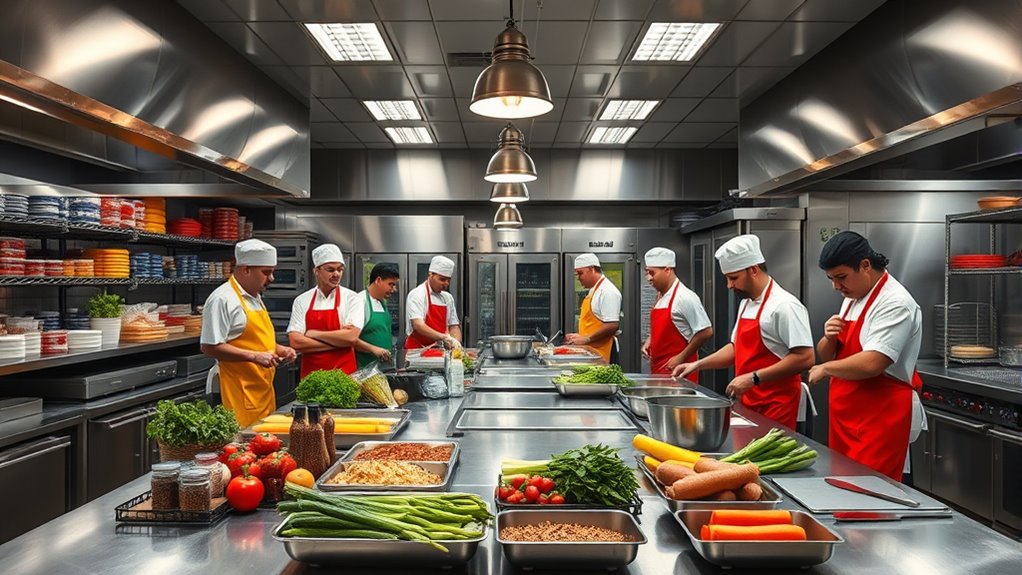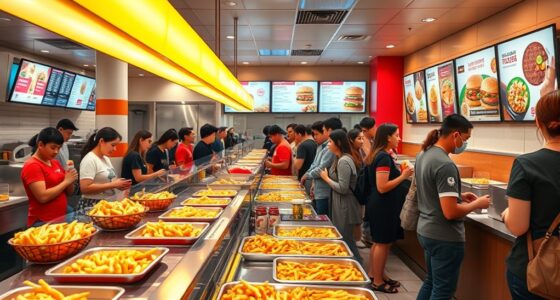A commissary kitchen is a fully equipped commercial space where food entrepreneurs and vendors can prepare, package, and store their products legally and safely. It offers shared appliances, workstations, and storage, helping you reduce costs and meet health regulations. These kitchens are ideal for small and growing food businesses looking to scale without investing in their own facility. Keep exploring to discover how these spaces can support your culinary goals and business growth.
Key Takeaways
- A commissary kitchen is a shared commercial space equipped for food production and preparation.
- It provides professional appliances, utensils, and storage to support small food businesses.
- Rent can be paid by hour or month, offering flexible, cost-effective access.
- It helps businesses meet health and safety regulations with necessary permits and sanitation standards.
- Commissary kitchens support scaling operations, packaging, and distribution for food entrepreneurs.
Defining a Commissary Kitchen
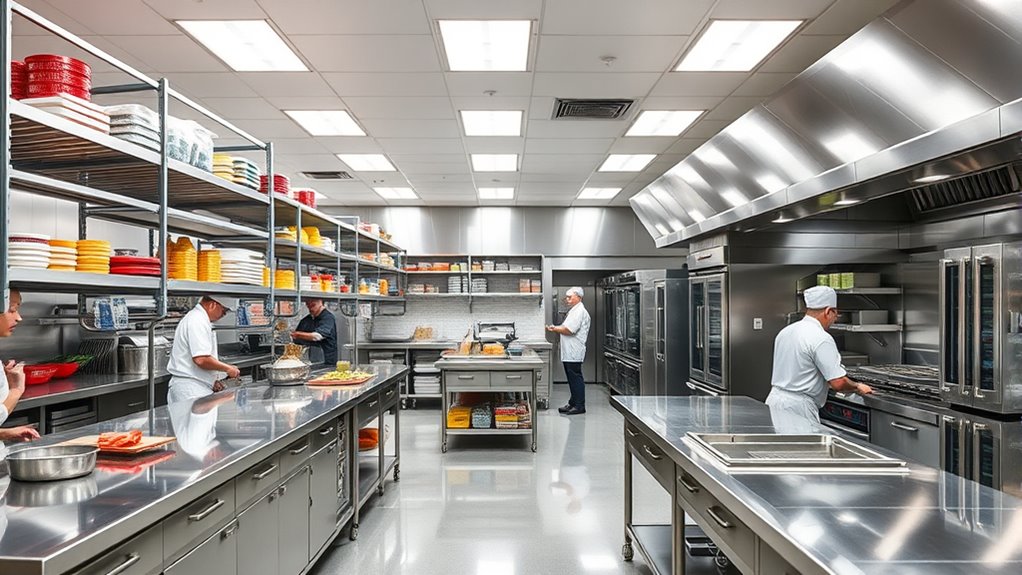
What exactly is a commissary kitchen? It’s a shared commercial space designed for food entrepreneurs and vendors to prepare, cook, and package their products. These kitchens are fully equipped with professional-grade appliances, utensils, and storage, giving you everything you need in one location. Instead of setting up your own licensed kitchen, you rent space by the hour or month, which helps cut costs and simplifies compliance with health regulations. Commissary kitchens often include additional services like packaging, labeling, and distribution support. They’re ideal if you’re starting a food business, looking for a commercial space without hefty investments, or seeking a flexible, compliant environment to scale your operations. Essentially, a commissary kitchen provides a professional, shared platform to turn your culinary ideas into reality.
The Origin and Evolution of Commissary Spaces
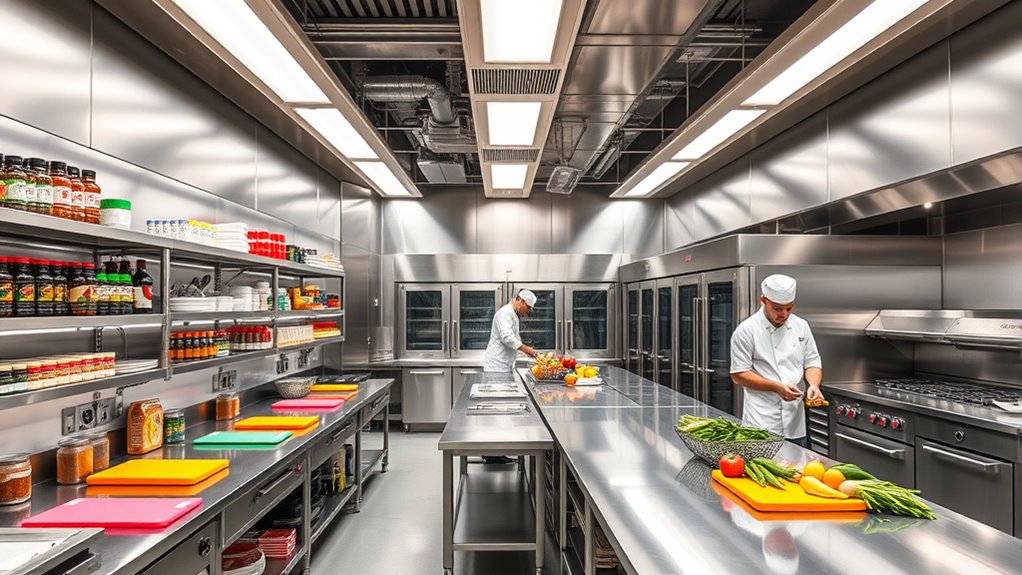
The concept of commissary kitchens has roots that date back to the early 20th century, when shared commercial spaces began to emerge in response to the needs of small food producers. During this time, local markets and community food hubs started to appear, offering affordable facilities for entrepreneurs to prepare and store their products. As regulations around food safety and sanitation grew stricter, these shared spaces became essential for compliance. Over the decades, the idea evolved with the rise of urbanization and the growth of the food industry, leading to modern commissary kitchens that combine multiple amenities. Today, they serve diverse food businesses, providing flexible, scalable environments that support innovation and growth. This evolution reflects the ongoing need for accessible, compliant, and cost-effective commercial kitchen solutions, much like how renewable energy sources promote sustainability and efficiency in modern systems.
Key Features and Amenities of Commissary Kitchens
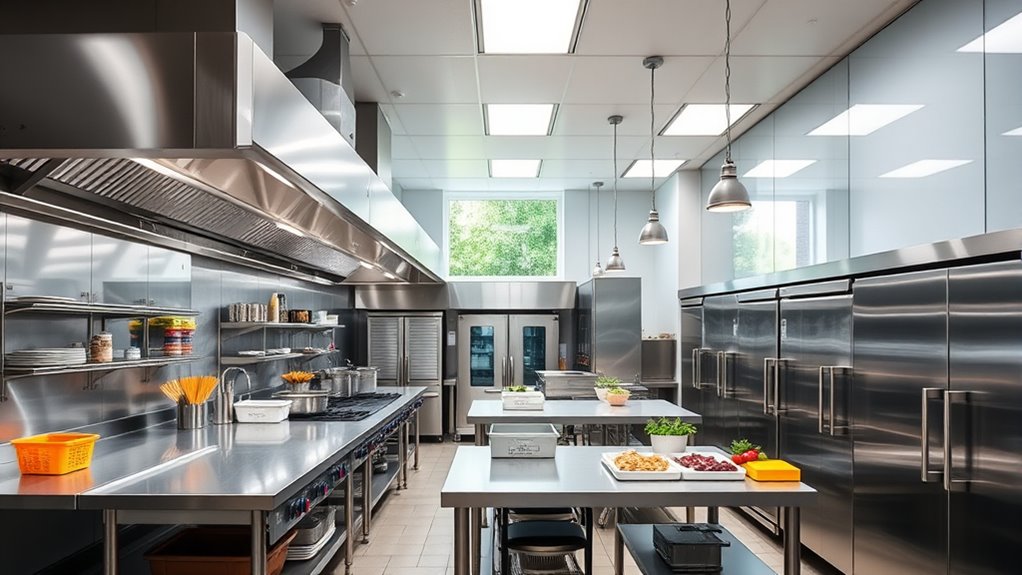
Commissary kitchens are equipped with a range of key features and amenities designed to support food entrepreneurs in their operations. You’ll find commercial-grade appliances like ovens, stoves, refrigerators, and freezers that meet health standards. Prep stations and worktables provide ample space for cooking and assembly, while storage areas keep ingredients organized and accessible. Many facilities include dishwashing stations to streamline cleaning, and some offer loading docks for easy supply deliveries. Safety features such as fire suppression systems, ventilation, and sanitation stations are standard to ensure a safe working environment. High-speed internet and secure access are often available to help coordinate orders and manage business activities. These amenities are essential in creating a professional, efficient space for your culinary ventures. Additionally, essential oils for health can be used to promote well-being and relaxation in the workspace.
How Commercial Food Businesses Use These Spaces
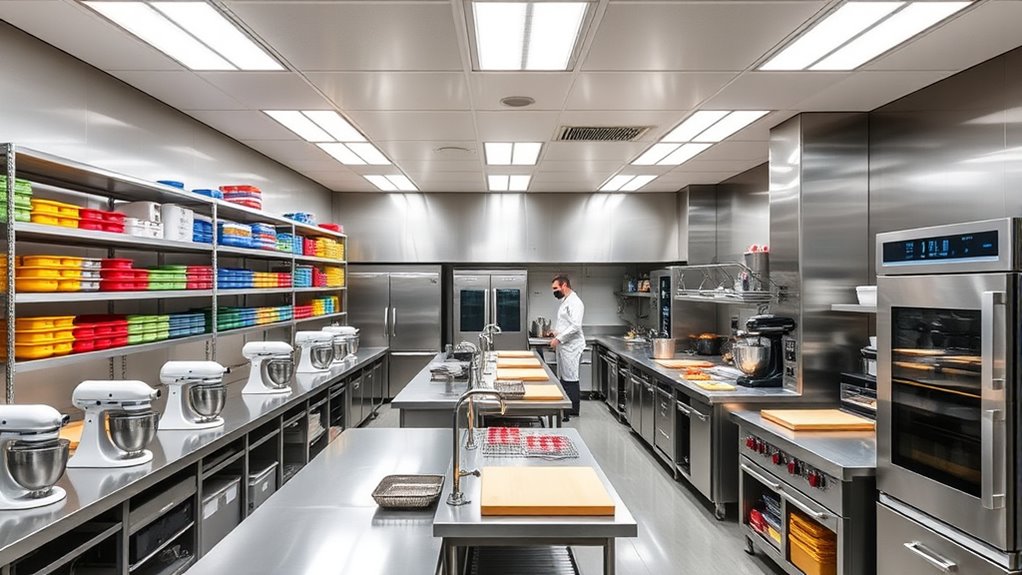
Many commercial food businesses rely on commissary kitchens to efficiently produce, package, and prepare their products. These spaces serve as central hubs where you can scale up production without the need for a dedicated storefront or separate facility. You might use a commissary to cook large batches, then package items for delivery or retail. They also provide storage for ingredients and finished goods, saving you space at your primary location. Additionally, commissary kitchens often include specialized equipment like commercial ovens, mixers, and refrigeration units, which can help streamline your operations. This setup allows you to focus on crafting quality products while minimizing overhead costs and logistical challenges. Moreover, understanding projector specifications can help you optimize your space for presentations or menu displays, enhancing customer engagement. Overall, commissary kitchens support your business growth by offering a flexible, fully equipped environment tailored to food production needs.
Legal and Regulatory Considerations
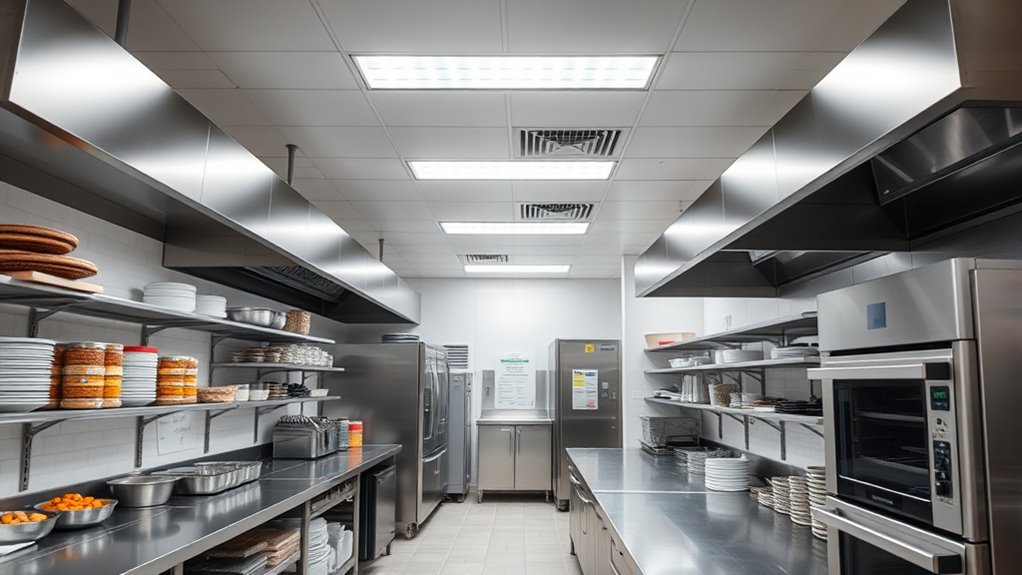
Managing legal and regulatory requirements is essential when using commissary kitchens for your food business. You must comply with local health codes, licensing, and inspection standards to operate legally. These regulations ensure food safety and protect consumers. Before starting, verify that the kitchen has the necessary permits and meets sanitation standards. Keep in mind that regulations vary by location, so research your area’s specific rules. Failure to comply can result in fines or shutdowns. To help, here’s a quick overview:
| Regulation Type | Key Requirement | Responsible Party |
|---|---|---|
| Health & Safety | Regular inspections and sanitation | Local health dept. |
| Licensing | Business and food permits | State/local authorities |
| Food Storage & Labeling | Proper labeling and storage practices | Your responsibility |
Stay informed and maintain documentation to ensure smooth operations. Being aware of regional legal resources can also help you navigate specific local requirements effectively.
Benefits for Small and Growing Food Enterprises

As a small or growing food business, a commissary kitchen offers a cost-effective way to produce your products without the high expenses of private space. You’ll benefit from shared equipment that saves money and time, helping you scale more efficiently. Plus, the streamlined licensing processes can get you up and running faster, so you can focus on growing your brand. Additionally, access to diverse shared facilities can expand your production capabilities and introduce you to other industry professionals.
Cost-Effective Production Space
Are high startup costs holding your food business back? A commissary kitchen offers a cost-effective production space, helping you save on equipment, rent, and utilities. Instead of investing in your own facility, you share a fully equipped kitchen with other entrepreneurs, reducing overhead. This setup allows you to focus your funds on product development and marketing. Plus, commisary kitchens often include amenities like storage and cleaning services, further lowering expenses. You gain access to a professional environment without the financial burden of building or leasing your own space. This makes it easier to scale up as your business grows or try new products without risking large investments. Overall, a commissary kitchen provides a flexible, affordable solution that keeps your startup costs manageable. Additionally, these shared spaces can offer insurer’s financial stability information, helping you ensure your business is protected as it grows.
Shared Equipment Benefits
Shared equipment in a commissary kitchen provides significant advantages for small and growing food businesses. It allows you to access high-quality appliances and tools without the hefty upfront costs of purchasing them yourself. This means you can focus your budget on other critical areas like ingredients or marketing. Using shared equipment also guarantees that your products meet health and safety standards, as the equipment is regularly maintained and sanitized. Additionally, it speeds up production, enabling you to scale operations quickly. Instead of waiting for your own equipment to become available, you can efficiently use shared resources to meet deadlines and demand. Moreover, understanding concepts like angel numbers can inspire confidence and positivity as you grow your business. Overall, shared equipment reduces expenses, improves efficiency, and helps you grow your food business more effectively.
Streamlined Licensing Processes
Streamlined licensing processes simplify the way small and growing food businesses get approved to operate. With fewer hurdles, you can start selling your products faster and focus on your craft. Commissary kitchens often have established relationships with local health departments, making inspections and paperwork smoother. This reduces delays and confusion, so you spend less time navigating bureaucracy and more time building your brand. Additionally, incorporating automation technologies can further streamline operations and improve overall efficiency. These benefits help you scale efficiently without getting bogged down in complex legalities. Overall, a commissary kitchen makes licensing straightforward, giving you more time to grow your food business.
Differences Between Commissary Kitchens and Incubators
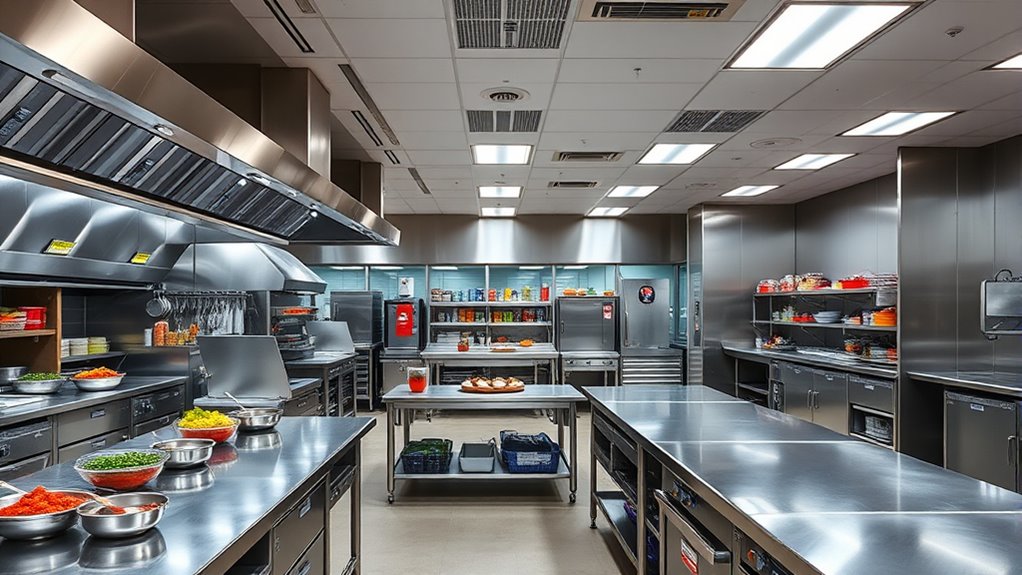
While both commissary kitchens and incubators support food entrepreneurs, they serve different purposes and operate under distinct models. Commissary kitchens are primarily shared commercial spaces where you rent equipment and workspace to produce food products. They focus on manufacturing and often cater to established brands needing a licensed facility. Incubators, on the other hand, are more all-encompassing support systems that include mentorship, business development, and networking opportunities. They aim to help early-stage food startups grow sustainably. Incubators often provide resources beyond just space, like marketing advice and funding connections. Fundamentally, a commissary is a commercial kitchen for production, while an incubator offers a broader ecosystem to nurture your business from idea to market. Additionally, some content discovery features of platforms like TikTok demonstrate how viral trends can significantly impact a food brand’s visibility and growth.
Cost Structure and Access Options
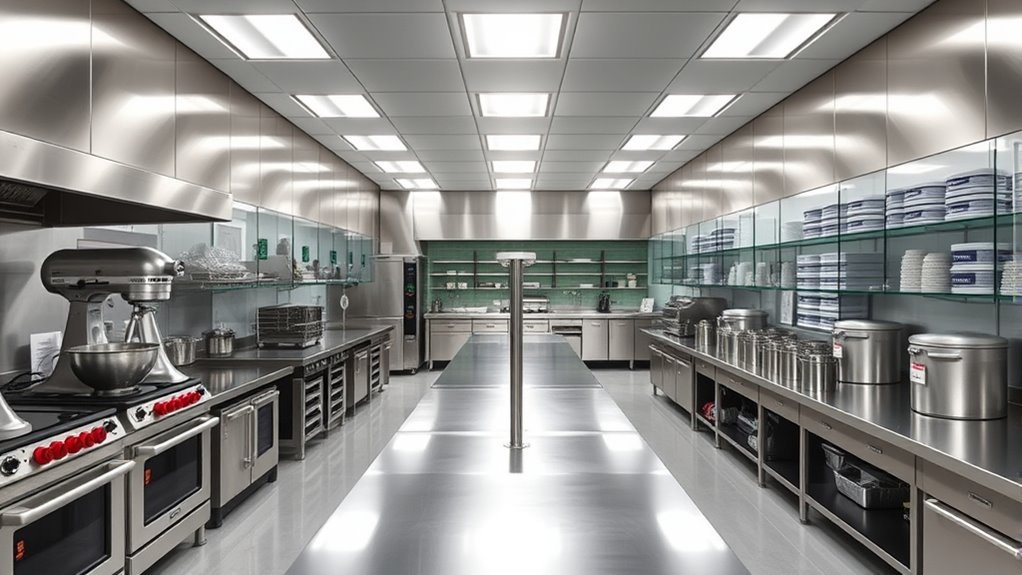
Understanding the cost structure and access options helps you choose the right commissary kitchen for your needs. You’ll want to compare fee models, membership plans, and strategies to maximize cost efficiency. Making informed decisions can save you money and streamline your production process. Additionally, considering the availability of specialized equipment or amenities, such as professional-grade appliances, can further influence your choice.
Fee Models Explained
Have you ever wondered how commissary kitchens manage their costs and offer different access options? They do this through various fee models that cater to different needs. Some kitchens charge a flat monthly fee, giving you unlimited access to workspace and equipment. Others use a pay-as-you-go approach, billing you based on hours used or specific services. There are also tiered pricing options, where costs increase with additional features like storage or refrigeration. Additionally, some commissaries take a revenue-sharing model, taking a percentage of your sales instead of fixed fees. These models allow flexibility and help you choose what fits your business stage and budget. By understanding these options, you can select the best fee structure to grow your food venture efficiently.
Membership and Access
Commissary kitchens offer a variety of membership and access options designed to meet different business needs. You can choose between full-time, part-time, or on-demand access depending on your schedule and production volume. Many facilities offer monthly memberships, which grant you 24/7 access, or pay-as-you-go plans for more flexibility. Some commissaries also provide tiered memberships, allowing you to select basic or premium access with added amenities like storage or refrigeration. Access is typically secured via key cards or digital entry, ensuring security and convenience. You’ll need to meet certain requirements, such as providing appropriate documentation or certifications. By understanding these options, you can select the membership plan that best fits your operational needs and budget.
Cost Efficiency Strategies
Choosing the right access options can substantially impact your overall costs, making it essential to evaluate how membership plans align with your budget and production needs. By selecting the most suitable plan, you can optimize expenses and avoid unnecessary fees. Consider these strategies:
- Shared workspace: Reduce costs by splitting rent and equipment expenses with other tenants.
- Pay-as-you-go: Only pay for the hours or equipment you use, preventing wasted resources.
- Long-term memberships: Lock in lower rates with extended commitments if your production is steady.
- Bulk ingredient purchasing: Leverage the commissary’s supplier relationships to save on ingredients and supplies.
These approaches help you maximize efficiency, control expenses, and keep your food business financially sustainable.
Future Trends in Shared Commercial Kitchens

As the food industry continues to evolve, shared commercial kitchens are poised to adopt innovative technologies that enhance efficiency and safety. Expect increased use of automation, such as smart appliances and inventory management systems, to streamline operations. Digital platforms will make booking, billing, and compliance tracking easier, reducing administrative burdens. Sustainability will also play a bigger role, with more kitchens integrating eco-friendly practices like energy-efficient equipment and waste reduction programs. Additionally, health and safety standards will advance through contactless check-ins and improved sanitation protocols. You’ll see more flexible layouts designed for versatile use, accommodating emerging food trends like ghost kitchens and virtual brands. Overall, these trends will make shared kitchens more adaptable, safer, and better equipped to meet the demands of modern food entrepreneurs.
Frequently Asked Questions
How Do I Find a Nearby Commissary Kitchen?
If you’re looking for a nearby commissary kitchen, start by searching online for local shared kitchen spaces or commercial kitchens in your area. You can also check industry directories or ask fellow food entrepreneurs for recommendations. Visit their websites or give them a call to see if they meet your needs. Don’t forget to explore social media groups or local business associations for additional options and firsthand reviews.
What Are Typical Rental Costs for a Commissary Space?
Did you know that rental costs for commissary kitchens typically range from $15 to $30 per hour? You’ll find that most facilities also offer daily or monthly rates, which can be more cost-effective if you plan to use the space regularly. Your expenses depend on location, kitchen size, and amenities. To stay within your budget, compare different options and consider whether you need a full-time or part-time setup.
Can I Operate My Food Business From a Commissary Part-Time?
You can operate your food business part-time from a commissary kitchen if the facility allows it. Many commissaries are flexible and cater to small or seasonal businesses, so you should check with the specific facility about their policies. Keep in mind, you’ll need to adhere to health regulations and schedule your usage accordingly. This setup offers a practical solution to manage your business without committing to full-time rental costs.
Are Commissary Kitchens Suitable for Large-Scale Food Production?
Think of a commissary kitchen as the engine powering your food business. For large-scale production, they’re often up to the task, offering ample space, equipment, and compliance. You’ll find them suitable if you’re aiming to scale up quickly and efficiently. Just keep in mind, some facilities have limits on capacity or hours, so it’s smart to check if they fit your specific needs before diving in.
What Safety Protocols Are Enforced in Commissary Kitchens?
You need to follow strict safety protocols in commissary kitchens to guarantee food safety and compliance. This includes regular sanitation of surfaces, proper storage of ingredients, and maintaining equipment hygiene. You’re also required to wear protective gear like gloves and hairnets, monitor temperature controls, and adhere to health regulations. By actively practicing these safety measures, you help prevent contamination and keep the kitchen a safe environment for everyone involved.
Conclusion
Now that you know what a commissary kitchen is and how it can support your food business, aren’t you ready to take the next step? These shared spaces offer a cost-effective, flexible solution for entrepreneurs like you, helping turn your culinary dreams into reality. With the right facility, you can focus on perfecting your products without the hassle of managing a full-time commercial space. So, why not explore the possibilities awaiting you in a commissary kitchen today?
